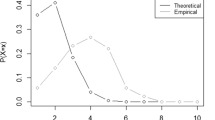Abstract
In this paper we model the United Kingdom’s Consumer Price Index as a complex network and we apply clustering and optimization techniques to study the network evolution through time. By doing this, we provide a dynamic, multi-level analysis of the mechanism that drives inflation in the U.K. We find that the CPI classes’ network exhibits an evolving topology through time which depends substantially on the prevailing economic conditions in the U.K. We identify non-overlapping communities of these CPI classes and we observe that they do not correspond to the actual categories they belong to; a finding that suggests that diverse forces are driving the inter-relations of the CPI classes which are stronger between categories rather than within them. Finally, we construct a reduced version of the U.K. CPI that fulfills the core inflation measure criteria and can possibly be used as an appropriate measure of the underlying inflation in the U.K. Since this new measure makes use of only 14 out of the 85 U.K. CPI classes, it can be used to complement the Bank of England’s arsenal of core inflation measures without the need for further resource allocation.








Similar content being viewed by others
Notes
The data was acquired from OECD’s database.
We construct the U.K. CPI network for every year between 2002 and 2014 but only include the figures of the years 2003, 2008, 2009 and 2013 for illustration purposes and for the sake of brevity. The rest of the network formulations are available upon request.
In the construction of the official Consumer Price Index each class of goods and services is weighted according to its expenditure share for each given period. However, since the newly created measures comprises only a subset of the 85 initial classes, the respective weights are recalculated to construct the new aggregate.
References
Acemoglu, D., Carvalho, V. M., Ozdaglar, A., & Tahbaz-Salehi, A. (2012). The network origins of aggregate fluctuations. Econometrica, 80(5), 1977–2016.
Allen, F., & Gale, D. (2000). Financial contagion. Journal of political economy, 108(1), 1–33.
Armour, J. (2006). An evaluation of core inflation measures. Bank of Canada.
Barabási, A. L., Albert, R., & Jeong, H. (2000). Scale-free characteristics of random networks: the topology of the world-wide web. Physica A: Statistical Mechanics and its Applications, 281(1), 69–77.
Blondel, V. D., Guillaume, J. L., Lambiotte, R., & Lefebvre, E. (2008). Fast unfolding of communities in large networks. Journal of Statistical Mechanics: Theory and Experiment, 2008(10), P10008.
Bryan, M. F., & Cecchetti, G. S. (1994). Measuring core inflation. Monetary Policy: The University of Chicago Press.
Cecchetti, S. G. (1996). Measuring short-run inflation for central bankers (No. w5786). National bureau of economic research.
Clark, T. E. (2001). Comparing measures of core inflation. Economic Review-Federal Reserve Bank of Kansas City, 86(2), 5–32.
Cogley, T. (2002). A simple adaptive measure of core inflation. Journal of Money, Credit and Banking, 34, 94–113.
Eubank, S., Guclu, H., Kumar, V. A., Marathe, M. V., Srinivasan, A., Toroczkai, Z., et al. (2004). Modelling disease outbreaks in realistic urban social networks. Nature, 429(6988), 180–184.
Euler, L. (1741). Solutio Problematis ad Geometriam Situs Pertinentis. Commentarii Academiae Scientiarum Imperialis Petropolitanae 8, 128–140, Opera Omnia (1), 7, 1–10.
Guimera, R., & Amaral, L. A. N. (2005). Functional cartography of complex metabolic networks. Nature, 433(7028), 895–900.
Kapetanios, G. (2004). A note on modelling core inflation for the U.K. using a new dynamic factor estimation method and a large disaggregated price index dataset. Economics Letters, 85(1), 63–69.
Laf, T., & Armour, J. (2006). Evaluating measures of core inflation. Bank of Canada Review, 2006(Summer), 19–29.
Mankikar, A., & Paisley, J. (2002). What do measures of core inflation really tell us?. Winter: Bank of England Quarterly Bulletin.
Mantegna, R. N. (1999). Hierarchical structure in financial markets. The European Physical Journal B-Condensed Matter and Complex Systems, 11(1), 193–197.
Marques, C. R., Neves, P. D., & Sarmento, L. M. (2003). Evaluating core inflation indicators. Economic Modelling, 20(4), 765–775.
Newman, M. E. (2004). Analysis of weighted networks. Physical Review E, 70(5), 056131.
Newman, M. E., & Girvan, M. (2004). Finding and evaluating community structure in networks. Physical review E, 69(2), 026113.
Papadimitriou, T., Gogas, P., & Sarantitis, G. A. (2013). An Analysis of the US Gross State Product Co-Movement using the Minimum Dominating Set. In Global Conference on Signal and Information Processing (GlobalSIP), 2013 IEEE (pp. 1145–1145). IEEE.
Papadimitriou, T., Gogas, P. , & Sarantitis, G. A. (2014). Convergence of European Business Cycles: A Complex Networks Approach. Computational Economics, 1-23.
Scott, R. (1997). A robust measure of core inflation in New Zealand, 1949–96. No. G97/7. Reserve Bank of New Zealand.
Shen, C., & Li, T. (2010). Multi-document summarization via the minimum dominating set. In Proceedings of the 23rd International Conference on Computational Linguistics (pp. 984–992).
Taghipour, H., Rezaei, M., & Esmaili, H. (2012). Applying surface-based DNA computing for solving the dominating set problem. American Journal of Molecular Biology, 2(3), 286–290.
Tse, C. K., Liu, J., & Lau, F. (2010). A network perspective of the stock market. Journal of Empirical Finance, 17(4), 659–667.
Acknowledgments
This research has been co-financed by the European Union (European Social Fund (ESF)) and Greek national funds through the Operational Program ‘Education and Lifelong Learning’ of the National Strategic Reference Framework (NSRF)—Research Funding Program: THALES (MIS 380292). Investing in knowledge society through the European Social Fund.
Author information
Authors and Affiliations
Corresponding author
Rights and permissions
About this article
Cite this article
Sarantitis, G.A., Papadimitriou, T. & Gogas, P. A Network Analysis of the United Kingdom’s Consumer Price Index. Comput Econ 51, 173–193 (2018). https://doi.org/10.1007/s10614-016-9625-9
Accepted:
Published:
Issue Date:
DOI: https://doi.org/10.1007/s10614-016-9625-9
Keywords
- Network analysis
- Threshold-minimum dominating set
- Community detection
- Core inflation
- Consumer price index




